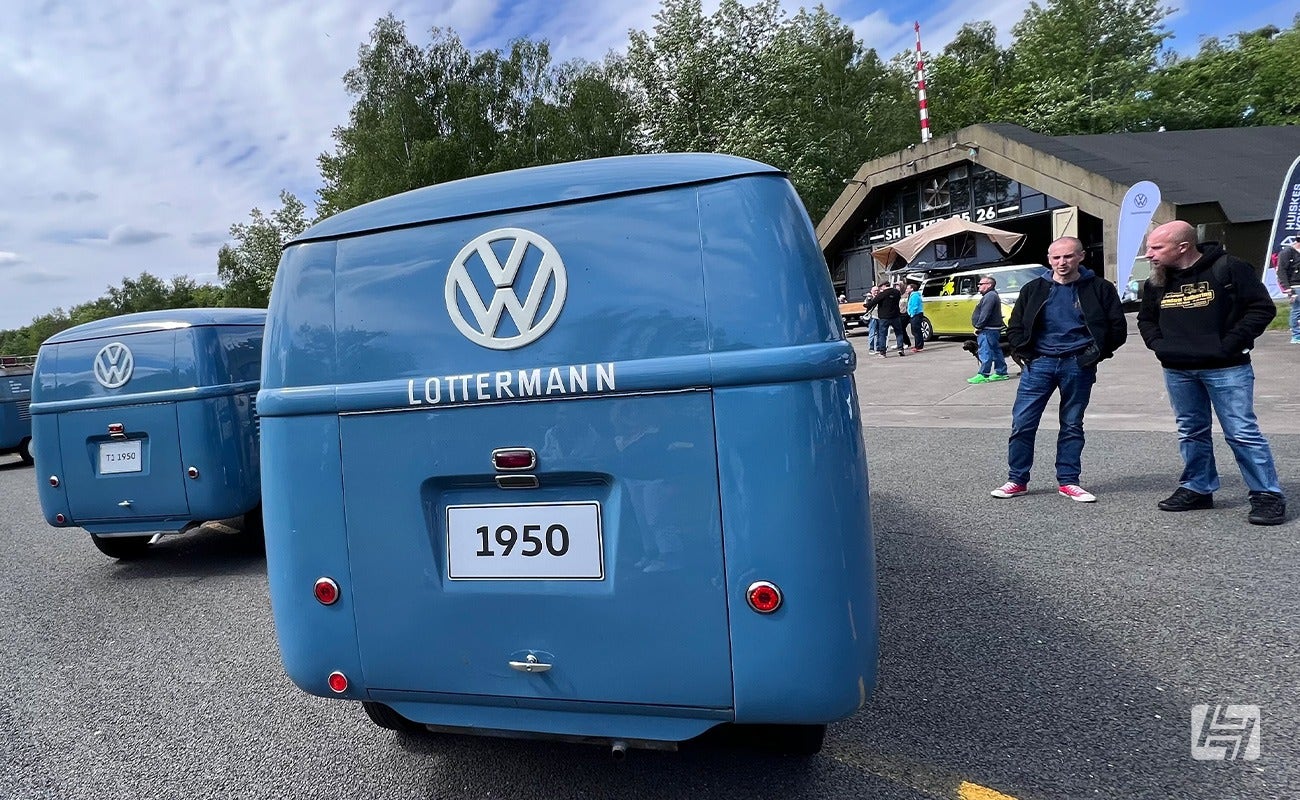VW Splitscreen Buying Guide
To many people, the dream VW bus or campervan has got to be a Split Screen. If you want to know whether you can afford to buy, run and fix one, or even what to look to ensure the dream doesn't turn into a nightmare, follow our buying guide below.
Split Screen History
Confusingly known as both the T1 (Transporter 1) or the Type 2 (as it followed the Type 1, the model designation for the Beetle) Volkswagen of Germany manufactured a range of models between 1950-67 with commercial vehicle roots; a Microbus with 13-23 windows, a panel van, and single and double cab pick-up. These are now more commonly referred to as the 'T2 Split' 'Split Screens' or 'Splittys' on account of the windscreen being split into two halves.
However further adding to the confusion, the first iteration of the VW 'twin screen' delivery vehicle, or indeed leisure vehicle, built between 1950-55 is now referred to as a 'Barndoor' model. But this is not, as one might expect in reference to the double side loading doors, but to the double height engine lid at the rear of the vehicle. These Barndoor models can also be easily identified from the front, by their lack of 'peek' over the front windscreens. Prices for these vehicles are considerably higher, and whilst they share the same shadow not all the parts cross over.
Whilst T2 Split production in Germany officially ended in 1967, when it was replaced by the Type 2 Bay Window, manufacturing continued in Brazil and South Africa (as CKD kits) well into the seventies. However, these later Split Screens (often called Fleetlines) are made from a mixture of different model year parts and generally command less when up for sale. Should you find a bargain deal it’s worthwhile checking whether it is an original German bus or a later Brazilian or S.A version - the VW chassis number will help to determine this.




Is a VW Split Screen for you?
Split Screens are trendy, but would you like to drive one every day? Probably not, especially if it is standard specification because the performance of the engine will feel slow, and the brakes are not comparable to a modern vehicle. However, there are numerous modifications that can help to update a Split Screen and make it more driveable without spoiling its originality.
It’s highly likely that you won’t want to drive a Split Screen every day, but perhaps drive it to shows and on holidays, in which case, the novelty value has less chance of wearing off. Providing you take your time, stopping every couple of hours to allow the engine to cool and accepting that a cruising speed of 50mph is acceptable, then a family holiday or trip to a show is the making of priceless memories.
If you want a Split Screen as a campervan, then many were converted during the Fifties and Sixties by aftermarket specialists such as Westfalia, Dormobile, and Devon. Finding an original conversion and sourcing any parts that need to be replaced may be difficult. Alternatively, buying a Split Screen with a modern, but period-looking interior conversion for camping is a better solution for family holidays, and there are numerous specialists who can help.
Many modern campervan conversions comply with better safety laws concerning seatbelt anchorage points and how a rock-and-roll bed is fitted. This will be important if you want to transport your children. Read up on whether your classic car requires seat belts here.






What is a VW Samba?
Arguably the holy grail of Splitscreen ownership is a 'Samba' bus which was available in both 21 and 23 window varieties, with 8 of these mounted into the roof, around a full-length fabric sunroof. If you have your heart set on one, and it matters that it is 'real' then be sure to check the documents carefully, as there are quite a few tribute Samba builds out there. Enthusiast owners are generally very honest about their vehicles' history, and will explain any modifications, should a vehicle have been converted earlier on in its life.


Tin or pop top?
An elevating roof (known as a pop top) helps to expand the interior space of a T2 Split, but it can come at a price. If you are looking at a vehicle for sale with a pop top, check the seals and condition of the fabric, which can leak water into the interior. Look for signs of dampness and mould, which must be removed as it could be a health hazard. A replacement seal kit for a Dormobile pop top is available, along with the roof straps (also called hold downs) for locking the pop top when it’s folded down. The canvas sides for the Westfalia pop top are also available.
Having no pop top, or what most people refer to as a tin top on account of the steel roof, limits the interior space. Whilst a limited number of factory 'all metal' high tops were made, there are also versions with GRP (glass-reinforced plastic) roofs which were fitted by a number of campervan converters. The permanent extra interior headroom is ideal when camping, but has an adverse effect on the vehicle’s aerodynamics, resulting in a lower top speed and greater fuel consumption. Plus, you probably won’t get into a car park with a height restriction barrier (also consider vehicle height if you have a roof rack fitted).




Will a VW Split Screen fit in my garage?
It's all well and good buying one, but where are you going to put it?! At 4.28m (14ft 5in) long and 1.72m (5ft 8in) wide, a Split Screen is roughly the same size as the first two generations of the Audi A3, so it should fit inside most garages. However, the height of the vehicle may be an issue, especially if it hasn’t been lowered, at almost two metres or over six feet tall (officially it should be 1.94m or 6ft 4in). And if a high top has been fitted, then you’ll definitely need a tall garage and a suitable door to get it through.
Not going to fit? A good quality car cover is another option to offer some weather protection for your new classic campervan.


Rusty Split Screens
The biggest problem for all Volkswagen Transporters, including the Split Screen, is corrosion. Even if a vehicle for sale promises to be immaculate and rot-free, check this for yourself, so take a magnet to check for filler, and a torch and something to lie on to look underneath. You’ll need to check the sills, floors, chassis rails, outriggers, and the front beam for corrosion and also for poor welding repairs.
Inspect the edges of the doors, engine lid, and all around the front panel. Look inside the engine bay for corrosion around the edges, especially where the battery is fitted and inside the back panel (below the engine lid). Feel around the wheel arches for rust and filler. Peel back the window seals a little to look for trapped moisture, bubbling paint, and rust.
Fortunately, repair and replacement body panels for Split Screen are available, ranging from the front panel to the engine bay. And exterior panels, such as the doors and engine lid are also available in some cases.
If you are looking for a Split Screen that has a patina of surface corrosion on its exterior, it’s just as important to check over it for structural rot, which should not be present. Light surface corrosion may look cool, but holes in the sills and arches will only get bigger. And find out how the surface corrosion has been preserved or treated to ensure it won’t go any further. A coat of lacquer or varnish often helps to ensure the corrosion doesn’t get any worse.






Split Screen engine trouble
A range of air-cooled flat-four engines were fitted as standard to the Split Screen, with sizes from 1100cc to 1600cc. The smaller 1100-1300cc motors in standard tune will struggle to cruise along at anything above 50mph, whereas the 1500cc and 1600cc motors are a little stronger on performance, but don’t expect to be overtaking trucks on the motorway.
Whatever air-cooled engine is fitted, look around it for oil leaks, starting with where the engine and gearbox are bolted together. Oil can leak from around here, which is often caused by the rear main oil seal turning brittle. Whilst a replacement seal can cost under £10, the engine will need to be removed to fit it.
Look for more oil leaks from the pushrod tubes on either side of the underneath of the engine. This is also usually caused by a failed seal and is a cheap-to-purchase part but could be labour-intensive if the heads have to come off. Spring-loaded pushrod tubes should save that hassle for you. You'll find them all on our website here.
Wiggle the crankshaft pulley forwards and backward to check the crankshaft end float. There should be about 0.15mm of movement, which is difficult to estimate, but if you can see the pulley moving, and you are confident it is securely fitted, internal bearing wear is more likely, and the engine will need rebuilding.
Top-end rebuild kits are available for Split Screen engines, and we also offer a range of non-exchange all-new engines from SSP if the issues are a bit more serious.
Where an engine has been modified, this may help improve its performance, but check it has the essential equipment to help preserve it. An oil pressure gauge and oil temperature gauge will help to keep an eye on the condition of the engine oil. An external oil cooler helps to keep the oil cool. And it’s important to have the correct tinware and seal fitted to regulate engine bay temperatures.


Gearbox checks
Originally, Split Screens were equipped with a four-speed manual gearbox. From the factory all T2 Split gearboxes were fitted with a reduction ‘box to lower the gear ratios and make it easier to move the vehicle when it was fully laden, as well as provide suitable ground clearance without excessive positive camber.
Whilst having a standard gearbox may be desirable for a Split Screen’s originality, many will have been replaced with one from a later Beetle, Karmann Ghia, or another model of VW often in conjunction with lowering the suspension. So, as a general guide, make sure the gears are easy to select – if they are not, there may be a problem with the bushings for the rod change mechanism and new gearshift bushes are available here.
During a test drive check the ‘box doesn’t jump out of the gears (4th and reverse are the common problems) and they are straightforward to select up and down, listening for crunching sounds that may indicate worn synchromesh. If you have any concerns over the gearbox, then budget for at least £800 for a professional rebuild. We list a number of gearbox components, which can be found here.


Splitscreen brakes
Drum brakes were fitted to all four corners of the Split Screen, although you may discover some have been modified with discs at the front or all-round. Disc brake conversion kits are available and are manufactured by brands such as EMPI and CSP, should you want to upgrade at a later date.
Whatever brakes are fitted, make sure the vehicle slows down in a straight line. If it pulls under braking then feel around for excessive heat after your test drive (don’t actually touch the wheels/ brakes) which could be caused by a sticky caliper, faulty wheel cylinder, or even an internally collapsed brake hose.


Splitty suspension
The Split Screen’s front suspension consists of a horizontally mounted twin-beam axle that is bolted to the chassis rails. Inside these beams, there are torsion leaf springs that are connected to the front wheel hubs via upper and lower suspension arms and finally to king and link pin spindles. As the suspension arms move up and down when the road wheel rides over an uneven surface, the torsion leaf springs twist to help control that movement. There are also telescopic shock absorbers to flatten out this undulation.
The rear suspension on a T2 Split Screen consists of a pair of spring plates connected to individual torsion bars that control the up-and-down movement of each rear wheel, along with a telescopic damper. Although, this may have been updated to a later swing axle or IRS (independent rear suspension) from another VW. In all cases, look for split bushes, leaking dampers, and signs of corrosion.
Lowering the suspension can make a Split Screen look extra cool, but it’s a big ask to expect it to still be comfortable to drive. The limited amount of suspension travel available due to a lowered ride height means the springs and dampers need to be stiffer. If you are looking at a Split Screen with lowered suspension, think carefully about the ride quality, have a test drive if possible, and find out what suspension components have been fitted. Brand names such as SSP, KYB, and Boge all manufacture Splitscreen suspension dampers designed for standard and lowered suspension set-ups - just be sure to check the measurements if you're running anything but the standard ride height.
Air or hydraulic suspension may have been fitted to more modified vehicles giving the luxury of adjusting the ride height at the flick of a switch. Enquire as to who installed this, and what system is fitted, if worried have a mechanic check it over before you hand over the cash.


Splitscreen steering
A steering box is fitted to all Split Screen models, which has a worm-and-peg mechanism and was originally manufactured by ZF and AE Ross. The upper steering column is pressed into the steering box case on the ZF type, whereas it’s bolted to it on the AE Ross.
Turn the steering wheel to see how much movement is required before the road wheels start to move. Some VW workshop manuals recommend a maximum of 25mm (one inch) of movement is acceptable, although the UK’s MOT laws state 75mm or almost three inches (based on a 380mm or 15-inch diameter steering wheel). Excessive movement could be caused by wear in the linkage and/or the box. Adjustment of the steering box may help to reduce it, but if not, it may need to be overhauled. We explain steering boxes in more detail on our blog here.


T2 Split Electrics
6-volt negative earth electrics were installed in Split Screens, and these batteries are still available, although many vehicles have now been converted to a 12-volt system.
Whilst there may be very few electrical components, do check they work! Test the windscreen wipers (they won't be fast) the horn, headlights, and indicators. Bad earths, water ingress, and corroded connections can cause numerous problems, so look over the fuse box and the wiring connections for collections of 'chocolate blocks' or bullet connectors that may have come loose. If all else fails, a new wiring loom can be purchased to put things back to how they should be.


Should I buy a VW Split Screen, and how much are they?
It’s arguably the dream VW, so surely everyone should own a Split Screen if they can afford to buy one, no? That may be the case, but choose wisely, pick over every detail, and make sure you know how much any required repairs will cost before committing yourself.
What does a VW Splitscreen cost? That's a tricky one to put a figure on. Don't expect to find a project for less than £5,000 and even then it's going to need a lot of love. Prices for Brazilian-built vans will come in around the mid-teens for something that you can drive home, and German-built buses are currently kicking off about £20,000 going up and up all depending on age, spec, and condition. Should you want a Barndoor model then the price can extend to the hundreds of thousands!
And if you still can’t decide, follow our guide to choosing a VW campervan, which may inspire you into buying a different model instead.
Best of luck.
Rob




 Beetle
Beetle
 Type 2 Bay
Type 2 Bay
 Type 2 Split
Type 2 Split
 Type 25
Type 25
 Transporter T4
Transporter T4
 Transporter T5
Transporter T5
 Golf Mk1
Golf Mk1
 Golf Mk2
Golf Mk2


 911
911
 996
996
 997
997
 986 Boxster
986 Boxster
 987 Boxster
987 Boxster
 912
912
 944
944
 924
924


 Defender
Defender
 Discovery Series 1
Discovery Series 1
 Discovery 2
Discovery 2
 Series 1, 2 & 3
Series 1, 2 & 3
 Freelander
Freelander
 Freelander 2
Freelander 2





